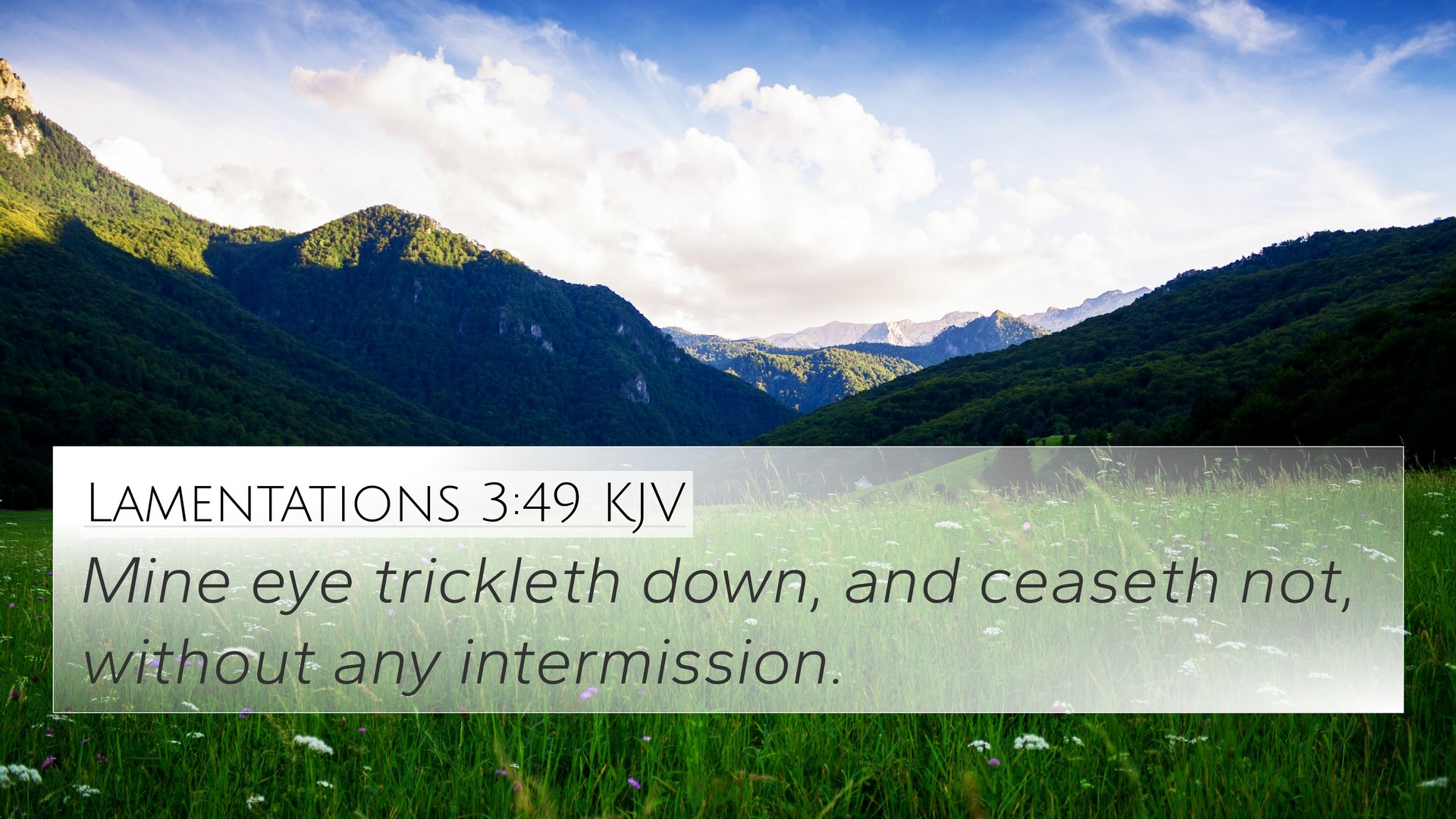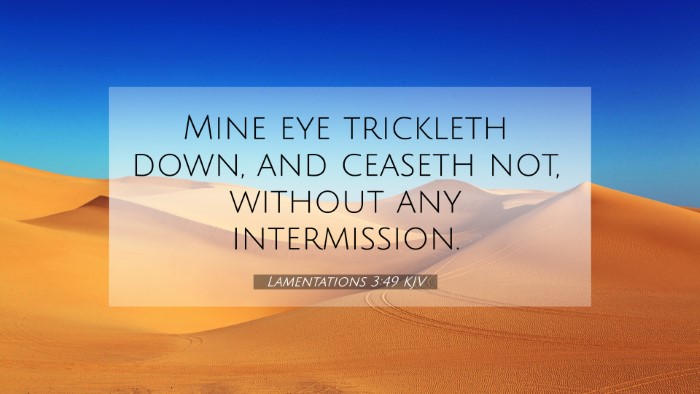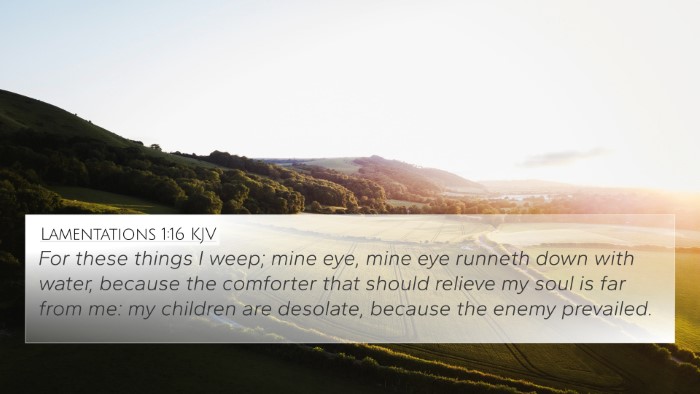Lamentations 3:49 - Verse Meaning and Interpretation
Lamentations 3:49 states, "Mine eye runneth down with rivers of water for the destruction of the daughter of my people." This verse captures a profound emotion of sorrow and anguish, presenting a vivid imagery of tears that are likened to rivers flowing due to overwhelming distress.
Summary of Insights from Public Domain Commentaries
This verse is part of a larger lament from the author, traditionally believed to be Jeremiah, who mourns the plight of Jerusalem and its people after the Babylonian conquest. The tears represent deep sorrow for the destruction and desolation experienced by the people, highlighting both personal grief and communal suffering.
-
Matthew Henry's Commentary:
Henry reflects on the depth of Jeremiah's lament, emphasizing the hopelessness and despair felt by the people of Israel in their suffering. He connects this verse to the broader theme of divine judgment and the consequences of sin, suggesting that such grief serves as a form of collective mourning for the national calamity.
-
Albert Barnes' Notes:
Barnes elaborates on the metaphor of the 'rivers of water', indicating that the tears symbolize not only personal sorrow but also an indictment of the community's loss. He explores the emotional landscape of the text, noting the intensity of the pain as Jeremiah identifies with his people's plight.
-
Adam Clarke's Commentary:
Clarke provides insight into the poetic structure of Lamentations, noting the use of imagery to evoke the psalmist's emotional turmoil. He underscores the universal nature of suffering, linking Jeremiah's tears to the experiences of all those who suffer calamity and seek God’s mercy.
Connections to Other Biblical Texts
Lamentations 3:49 is deeply interconnected with various other scriptures that reflect themes of mourning, repentance, and divine judgment. Below are selected verses that resonate with the message of Lamentations 3:49:
- Psalms 126:5-6: "They that sow in tears shall reap in joy." This verse captures the cycle of sorrow and future hope, drawing a link between lamentation and eventual restoration.
- Ezekiel 18:30: "Therefore I will judge you, O house of Israel, every one according to his ways, saith the Lord God. Repent, and turn yourselves from all your offenses." This invokes the theme of repentance in the face of communal calamity.
- 2 Chronicles 7:14: "If my people, which are called by my name, shall humble themselves, and pray, and seek my face, and turn from their wicked ways..." This emphasizes the need for collective penitence in times of national crisis.
- Matthew 5:4: "Blessed are they that mourn: for they shall be comforted." This New Testament perspective aligns with the sorrow portrayed in Lamentations, emphasizing comfort in mourning.
- Lamentations 1:16: "For these things I weep; mine eye, mine eye runneth down with water..." This earlier verse mirrors the theme of tears and sorrow during the lamentation of the city.
- Isaiah 53:3: "He is despised and rejected of men; a man of sorrows, and acquainted with grief." This prophetic verse relates to the sorrow experienced by a leader, embodying the collective anguish of the nation.
- Revelation 21:4: "And God shall wipe away all tears from their eyes..." This offers a future hope that contrasts the current sufferings described in Lamentations, providing a theological perspective on suffering.
Thematic Connections
The lament expressed in Lamentations 3:49 also relates to broader themes in the Bible concerning:
- Divine Judgment: The sorrow articulated is often accompanied by a recognition of sin and the need for repentance.
- Collective Mourning: Many scriptures address the importance of community in both grief and restoration, illustrating God’s desire for unity in times of trouble.
- Hope and Restoration: There is often a narrative arc in scripture that, following lament, leads to hope and eventual restoration, which believers hold onto in times of despair.
Tools and Methods for Cross-Referencing Biblical Texts
Understanding the connections between biblical verses requires effective tools and methods. Suggested practices for enriching your study include:
- Bible Concordance: Use a concordance to locate specific words and phrases in the Bible, enabling a deeper exploration of related verses.
- Bible Cross-Reference Guide: Utilize guides that offer thematic and thematic verse connections, aiding in comparative analysis.
- Cross-Reference Bible Study: Engage in study methods that encourage tracing themes and emotions across scripture for a holistic understanding.
- Identifying Connections: Regularly note and analyze links between verses during personal study or sermon preparation.
Final Thoughts
Lamentations 3:49 serves as a poignant reminder of the human capacity for sorrow while also opening the door to hope through God's promise of comfort and restoration. By exploring this verse in conjunction with other scriptures, one can gain a fuller understanding of God's justice, mercy, and the communal aspects of faith amidst suffering.





